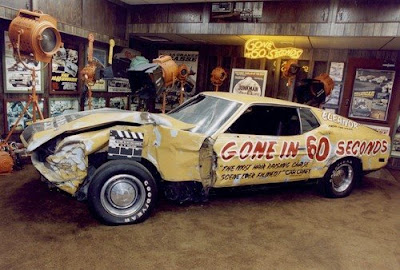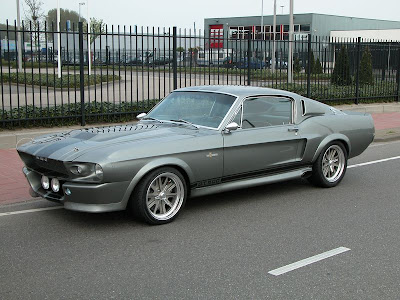In Halicki Films, LLC v. Sanderson Sales & Marketing, plaintiff Denice Shakarian Halicki and various related entities owned some rights – exactly what, to be decided by the court – in Eleanor, billed as “the only Ford Mustang in history to receive STARRING credit in a motion picture.”
There are really two Eleanors: a yellow 1971 Fastback Ford Mustang customized to look like a 1973 Mach 1 Fastback Mustang that appeared in the original 1974 “Gone in 60 Seconds” starring Toby Halicki
and a gray 1967 Shelby GT-500 from the 2000 remake “Gone in Sixty Seconds” starring Nicolas Cage and Angelina Jolie.
Toby Halicki’s widow, Denice, owned the rights in the 1974 film and also the original automobile:

Halicki showed the Original Eleanor at car shows and licensed the name and likeness for a line of toy cars. In 1995 she sold the rights to remake the film to Hollywood Pictures, a division of Walt Disney. In the agreement, Halicki retained the “right to manufacture, sell and distribute merchandise utilizing the car known as ‘Eleanor’ from the Original [film].”
Defendant Carroll Shelby developed the Remake Eleanor used in the new film. Shelby is no stranger to intellectual property rights and is a fairly frequent trademark litigant. He (or his trust) owns at least 49 active U.S. trademark applications or registrations, including “GT-500” and “Shelby” for automobiles. After the picture was released, Shelby filed applications to register the trademark “Eleanor” for model cars and automobiles and licensed the marks “Shelby GT-500” and “Eleanor” to Unique Motors for the manufacture of replica Remake Eleanor automobiles.
Halicki sued Shelby for copyright and trademark infringement. The copyright infringed was of the fictional character Eleanor; the infringed trademarks were “Eleanor” and “Gone in 60 Seconds.” The district court held on summary judgment that Halicki didn’t have standing for the copyright, trademark, unfair competition and related declaratory judgment claims because she did not own any rights in Remake Eleanor.
The agreement between Hollywood Pictures and Halicki was far from explicit about what rights Halicki might have in the derivative work Remake Eleanor. The grant of rights for the remake obtusely carved out “‘Eleanor’ from the Original [film]” for Halicki. Was it belt and suspenders to make sure that there was no question Halicki retained the rights in Original Eleanor? Did the contracting parties mistakenly assume that Original Eleanor would be used in the remake and didn’t consider the possibility that Remake Eleanor would be different? Was it a poorly drafted but deliberate retention of ownership of any derivative works of Eleanor created for the remake?
The court found that the agreement was “reasonably susceptible to the interpretation [Halicki] urges” but did not “command Halicki’s interpretation,” so therefore under California law considered extrinsic evidence. Halicki had declarations from her attorneys in the movie negotiation that it was clear to all parties that Halicki would retain all rights to Eleanor in the remake. In her own declaration, Halicki said that her retention of the merchandising rights to Eleanor was a non-negotiable deal point. Later, on a request for reconsideration, Halicki also provided an “Acknowledgement and Agreement” between Hollywood Pictures and Halicki which stated that “as between [Hollywood Pictures] and Halicki, Halicki retained the merchandising rights to that cetain car called ‘Eleanor’ as such car appears in the Remake . . . .”
Stating “this is not the more usual situation where parties to an agreement disagree as to the meaning of its terms” and noting “[h]ere, statements by both parties to the Agreement . . . demonstrate that each party had the same intention as to the meaning,” the appeals court concluded that the extrinsic evidence was unequivocal and Halicki owned the rights to Remake Eleanor.
The district court also made significant missteps regarding trademark standing, corrected by the appeals court. First, the district court held Halicki didn’t have standing to claim infringement of the “Eleanor” mark because she didn’t own a registration; the appeals court remanded for the district court to decide whether she was the owner of the unregistered mark. The district court also held Halicki didn’t have standing to sue on the “Gone in 60 Seconds” mark because her registration was for toy cars and baseball caps but the infringement was for use of the mark on actual cars. Also wrong, as explained in more detail by the Seattle Trademark Lawyer.
But the story between the lines is the one that interests me the most. It would have been a bold move by Carroll Shelby to apply to register “Eleanor” and license replica cars without an agreement with Hollywood Pictures that, as between it and Shelby, Shelby was the owner of the rights in the car. The “Acknowledgement and Agreement” from Hollywood Pictures, nine months in the making, was carefully worded to describe only the relative rights of Halicki and the studio, and obtained only after summary judgment was entered against Halicki. Hollywood Pictures is right in the middle of all this – did it recognize the conflict but knew it could reconcile the two agreements? Or did it mistakenly grant the same thing to two entities? Will a lawsuit between Shelby and Hollywood Pictures be next?
Halicki Films, LLC v. Sanderson Sales & Marketing, NO. 06-55807, 06-55806, 2008 U.S. App. LEXIS 23396 (9th Cir. November 12, 2008).
© 2008 Pamela Chestek


